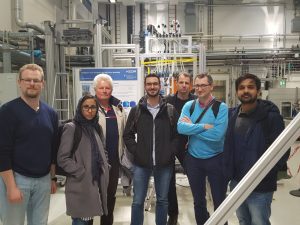Tomography-controlled Inline Fluid Separation
Contributing Partners:
Delft University of Technology (The Netherlands), Helmholtz-Zentrum Dresden-Rossendorf (Germany), Institut National Polytechnique de Toulouse (France), Lodz University of Technology (Poland)
Teletronic Rossendorf GmbH (Germany), CERG Fluides S.A.S. (France), Frames Group B.V. (The Netherlands), Linde AG (Germany), Total S.A. (France), Shell Global Solutions International BV (The Netherlands)
 State of the art: For a long time gravitational separators have been massively used in mechanical fluid separation in the chemical and the oil and gas industry. Flow splitters are an advanced concept with superior features. Apart from a gross reduction in investment costs and footprint they can achieve much faster the same separation quality and hence accelerate production times by orders of magnitude. The principle is simple in concept. Fluids of different density are set into circular motion by a swirl element in a slim flow channel. Centrifugal forces up to 100 times the gravitational acceleration separate the phases. Hence, the lighter one swirls to the centre of the originating vortex structure and is there being extracted by a so-called pick-up tube. Tricky features are the transient and non-linear waviness of the interface and vortex stability for changing inlet phase fractions. High turbulence intensities back-mix the separated fluids and high shear rates produce small droplets that are difficult to separate. In liquid-liquid separation this will even lead to development of emulsions, which are difficult to break because of coalescence hindering by charged interfaces.
State of the art: For a long time gravitational separators have been massively used in mechanical fluid separation in the chemical and the oil and gas industry. Flow splitters are an advanced concept with superior features. Apart from a gross reduction in investment costs and footprint they can achieve much faster the same separation quality and hence accelerate production times by orders of magnitude. The principle is simple in concept. Fluids of different density are set into circular motion by a swirl element in a slim flow channel. Centrifugal forces up to 100 times the gravitational acceleration separate the phases. Hence, the lighter one swirls to the centre of the originating vortex structure and is there being extracted by a so-called pick-up tube. Tricky features are the transient and non-linear waviness of the interface and vortex stability for changing inlet phase fractions. High turbulence intensities back-mix the separated fluids and high shear rates produce small droplets that are difficult to separate. In liquid-liquid separation this will even lead to development of emulsions, which are difficult to break because of coalescence hindering by charged interfaces.
 TOMOCON objectives: We develop for the first time ever the concept of tomography-controlled inline fluid separation. Wire-mesh and Electrical Capacitance Tomography sensors measure inlet flow conditions (flow regime, phase fractions) upstream and vortex parameters (interface, dispersion state) downstream the swirl element at high speed. A subsequent controller drives pick-up tube or blade actuators to follow the vortex fluctuations in real-time. Frame rates above 1000 Hz and a fast data processing scheme with < 100 ms latency are targeted. New electro-coagulation approaches with controlled electrical fields for emulsion destruction shall be designed from first principles and incorporated. Advanced two-phase CFD simulation including electrostatic fields for electro-coagulation are used and improved to model the process. The two-phase configuration in a separator is most challenging for CFD simulation. Scales are ranging from ~ 1 m length of the device down to the smallest bubbles and drops at ~ 10-6 m the numerical strategy needs to combine sub-grid modelling of the dispersed phase and the resolution of the interfaces of large scale. The idea is to combine Lagrangian tracking for the sub-grid bubbles with the VoF/Level Set method for the large resolved interfaces, a concept that was just recently developed and implemented in the JADIM code. For demonstration the large-scale Delft Inline Separator Facility (DISE) is used. This unique facility with its 10 cm inner diameter test section for inline separation experiments can be operated in an industrial range of oil-water volume fractions, high Reynolds numbers and centrifugal forces up to 200 g. The facility is fully instrumented with flow meters, pressure transducers, a boroscope and advanced flow measurement techniques, such as 2D LDA and PIV, and can run automatically.
TOMOCON objectives: We develop for the first time ever the concept of tomography-controlled inline fluid separation. Wire-mesh and Electrical Capacitance Tomography sensors measure inlet flow conditions (flow regime, phase fractions) upstream and vortex parameters (interface, dispersion state) downstream the swirl element at high speed. A subsequent controller drives pick-up tube or blade actuators to follow the vortex fluctuations in real-time. Frame rates above 1000 Hz and a fast data processing scheme with < 100 ms latency are targeted. New electro-coagulation approaches with controlled electrical fields for emulsion destruction shall be designed from first principles and incorporated. Advanced two-phase CFD simulation including electrostatic fields for electro-coagulation are used and improved to model the process. The two-phase configuration in a separator is most challenging for CFD simulation. Scales are ranging from ~ 1 m length of the device down to the smallest bubbles and drops at ~ 10-6 m the numerical strategy needs to combine sub-grid modelling of the dispersed phase and the resolution of the interfaces of large scale. The idea is to combine Lagrangian tracking for the sub-grid bubbles with the VoF/Level Set method for the large resolved interfaces, a concept that was just recently developed and implemented in the JADIM code. For demonstration the large-scale Delft Inline Separator Facility (DISE) is used. This unique facility with its 10 cm inner diameter test section for inline separation experiments can be operated in an industrial range of oil-water volume fractions, high Reynolds numbers and centrifugal forces up to 200 g. The facility is fully instrumented with flow meters, pressure transducers, a boroscope and advanced flow measurement techniques, such as 2D LDA and PIV, and can run automatically.


